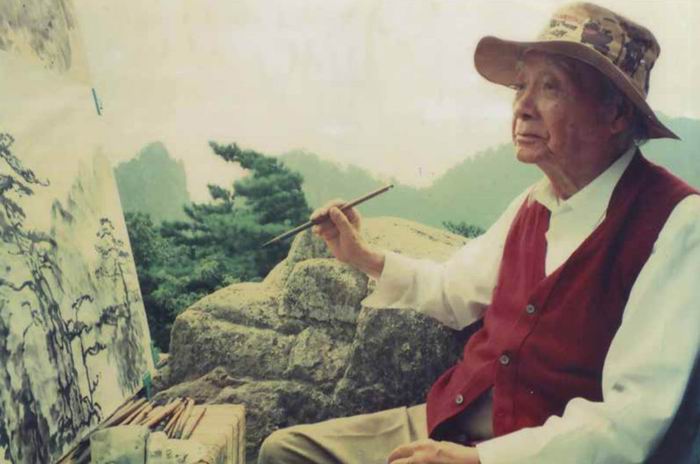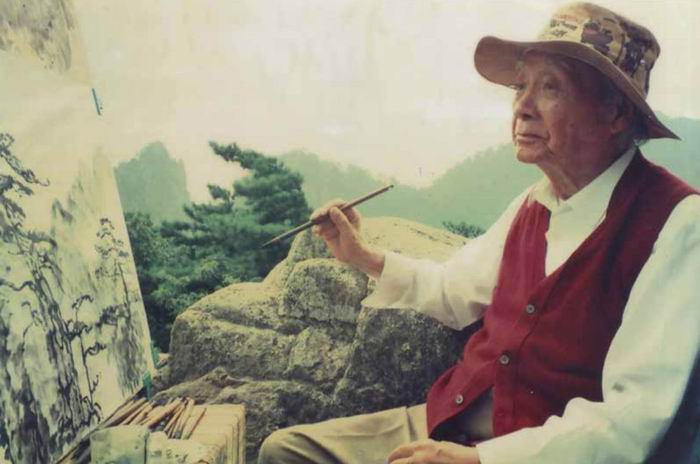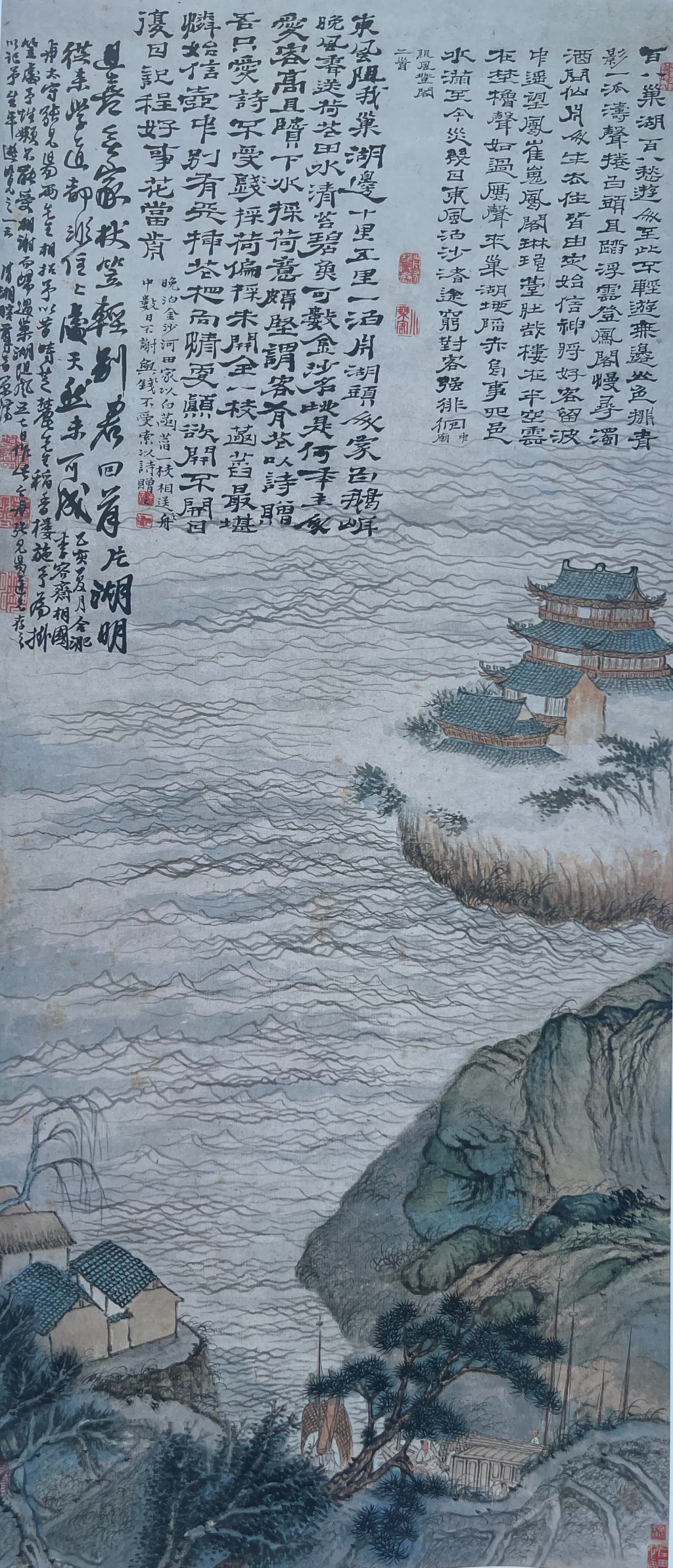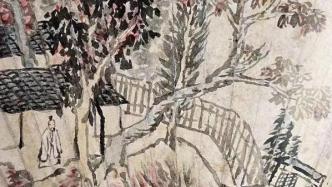
Shitao had a deep connection with Yangzhou. He had been there at least four times before settling in Yangzhou. In his later years, Shitao settled in Yangzhou and began to build a "home" for himself. "Dadi Thatched Cottage" was Shitao's final destination. Some researchers say that Dadi Thatched Cottage has old trees and houses, halls and pavilions, and has quite a garden feature, but this is probably not the case. Because of his residence "Dadi Thatched Cottage", Shitao also gave himself the nickname "Dadizi" in the last few years of his life.

A detail of Dadi Thatched Cottage in Shi Tao's landscape fan painting "Enjoying Autumn in the Mountain" (collected by Shanghai Museum). The postscript to this painting reads: "Yu Ruo Weng came from Qinhuai to visit me under Dadi Cottage...I asked him to write a few strokes. The old man in the courtyard seemed to have a sad autumn mood in his heart."
The old Yangzhou city was divided into two parts, east and west, namely the new city and the old city. The old city was expanded eastward in the 35th year of Jiajing in the Ming Dynasty (1556) to form the new city. The east wall and two gates of the old city were retained, and the moat originally surrounding the east wall of the old city became a north-south traffic waterway in the new city.
Because the Grand Canal, which connects China's north and south transportation artery, surrounds it, and because government units represented by the Lianghuai Salt Transport Bureau are located here, and salt merchants and shipping companies have their headquarters here, Yangzhou has become a prosperous city with both administrative management and commercial operations.
Shitao had a deep connection with Yangzhou. Before settling in Yangzhou, he had visited the city at least four times.
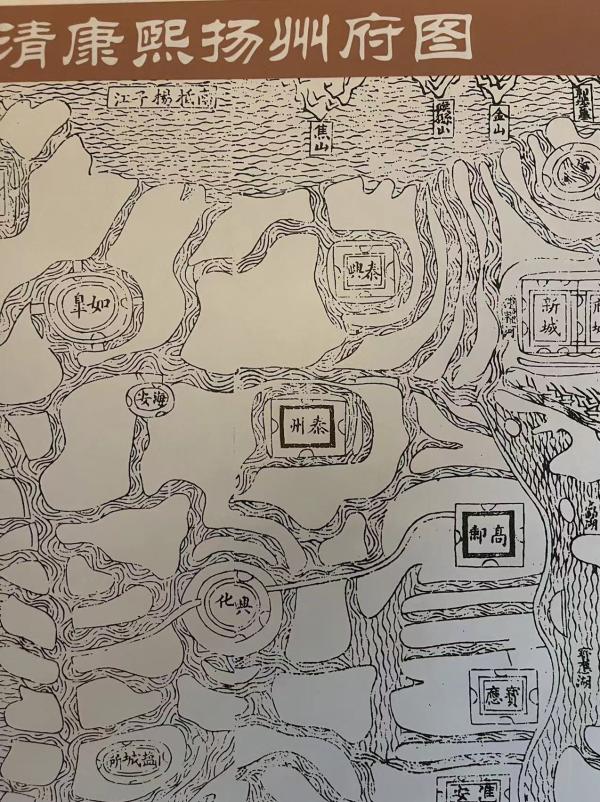
Map of Yangzhou Prefecture during the reign of Emperor Kangxi of the Qing Dynasty
Shi Tao's master Mu Chen Dao Yin (1596-1674) was the abbot of Jinghui Temple, one of the eight famous temples in Yangzhou. In the 12th year of Emperor Kangxi's reign (1673), when Shi Tao, 32 years old, first came to Yangzhou, he lived in Jinghui Temple. The abbot at that time was Xiang Guang Ben Ji, who was Shi Tao's uncle in terms of seniority. Xiang Guang Ben Ji passed away in the 20th year of Emperor Kangxi's reign (1681), and his apprentice Po Yu Yuan Zhi took over as abbot. After that, whenever Shi Tao came to Yangzhou, he would basically live in Jinghui Temple, and he was believed to be taken care of by Po Yu Yuan Zhi.
Jinghui Temple is located on the west side of the ancient Grand Canal outside the south gate of Yangzhou, in the present-day Peizhuang Village of Shuangqiao Township. It was first built in the early years of the Song Dynasty. It was originally a Xi family garden and later converted into a temple. During the Shunzhi period of the Qing Dynasty, the monk Zhaoji began to build a Zen hall and invited the famous monk Mu Chen Daoyin to live there. In the 16th year of Shunzhi (1659), Daoyin was summoned to the palace to preach to Emperor Shunzhi. Emperor Shunzhi bestowed the title of Master Hongjue on Daoyin, and wrote the couplet "The great Dharma protector does not see the monk's faults, and the good knowledge can adjust the feelings of things" and gave a seven-character poem to the temple.
After Daoyin, Jinghui Temple gradually declined. Later, Wu Jialong from Shexian County rebuilt it, and Yang Maoxun, the governor of the river channel, built a hall for the temple. In the second year of Emperor Kangxi's reign (1663), Zhang Zheng, the imperial censor of salt, and Lei Yingyuan, the prefect, rebuilt the Heavenly King Hall and dormitories; in the 44th year (1705), Emperor Kangxi toured the south and gave the temple a couplet: "It is truly a Buddhist country with fragrant clouds, not counting the laurel trees of Huaishan"; in the 46th year (1707), Emperor Kangxi gave the temple a plaque of "Jinghui Temple" and a poem fan, a golden Buddha and other items. According to records, the circumference of Jinghui Temple at that time was more than one mile, with a square wall in front and a bamboo forest in the back. The halls were scattered and the tower of Mu Chen Daoyin stood in the temple. This was the heyday of Jinghui Temple.
In the third year of Emperor Xianfeng's reign (1853), it was destroyed by the Taiping Rebellion.
In the 32nd year of the reign of Emperor Kangxi (1693), Shitao, who no longer had any illusions about the imperial capital, left Beijing and returned south to Yangzhou.
In the 34th year of Emperor Kangxi's reign (1695), Shitao temporarily left Yangzhou and went to Yizheng, Chaohu, and Hefei. In the autumn, he stayed at Jinghui Temple. Later, he stayed in Xu Songling's garden.
At the turn of spring and summer of this year, Shi Tao wrote a poem on the Chaohu Lake painting:
Fortunately, I have no home and my walking stick and hat are light. When I look back after saying goodbye to you, the lake is bright.
Learning the Dao is never about staying, and staying is not something that can be achieved naturally.
There is a note under the poem: "In the summer of Yi Hai, Prime Minister Li Rongzhai and Governor Zhang Jianyang of Hefei invited me to hang my hat in the Daoxiang Tower that was given to me by Master Zhilu. I was lazy by nature and could not accept it, so I thanked them and went home."
In Lu Xinyuan's "Rangli Pavilion Records" Volume 36 "Shi Tao and Fang Wenshan's Calligraphy and Painting Collection", Shi Tao wrote a poem on the colored landscape on the third page:
Without hair or crown, they are like two different things, interpreted as a fishing rod in the painting.
I don’t know where the reed flowers are in the shallow water, but I am trying to clean up the vast world.
Obviously, Shitao's trip to Anhui was to find a place where he could settle down. It was only five years from the time when he was "without a crown and hair" to the time when he wrote to Bada Shanren saying that he was "a man with a crown and hair."
The Yangzhou where Shitao lived in his later years was no longer the Yangzhou of 40 years ago. At this time, Yangzhou was a distribution center for officials and civilians in six provinces, including Jiangsu, Anhui, Jiangxi, Hunan, Hubei and Henan. Merchants from various provinces gathered in Yangzhou, and Yangzhou's business was prospering day by day. It had recovered from the war.

Yangzhou Xiaoqinhuai where Dadi Thatched Cottage is located
The canal flows northward around the city to Guazhou. The area along the river in the southeast of the city is called Hexia. Most merchants gather in Hexia, where they do business and have banquets. There are also more and more wealthy merchants who are keen on collecting paintings. Unlike some political centers such as Beijing and Nanjing, the calligraphy and painting market is very active. Many elegant merchants became friends of Shitao.
Especially some Huizhou merchants, they are more important in Shitao's life.
Huizhou Prefecture consisted of Shexian, Xiuning, Wuyuan, Qimen, Yixian and Jixi counties, so the so-called "Huizhou merchants" could come from any of these counties - some statistics show that people from Shexian are mainly salt merchants, people from Xiuning are mainly pawnbrokers, and people from Qimen are mainly tea merchants - most of the Huizhou merchants in Yangzhou are from Shexian, and Xiuning ranks second. However, most of the Xiuning people are more engaged in salt county trade in Liangzhe rather than Lianghuai.
There is an extremely interesting historical document in the "Lan of Scholars, Merchants and Workers" published in the Ming Dynasty: the route between Yangzhou Prefecture and Huizhou starts from Yizheng, not from Yangzhou Prefecture City; in addition, the salt permit was issued by Nanjing, not Yangzhou. Geographically speaking, Yizheng is closer to Nanjing than Yangzhou. Therefore, Yizheng is an important center of commercial activities on the north bank of the Yangtze River and the location of the Salt Administration Supervisory Control. Salt exported must be weighed here and transferred from the salt transport barges used in the Huai-Yang Canal to large ships that can sail on the Yangtze River.
Once you understand this, you will know why some of Shitao’s important friends lived in Yizheng.
Because Yangzhou was a transportation hub at the time, prosperous and wealthy, many of Shitao's old friends also lived in Yangzhou.
Comparing Shitao's works created during this period, we can often find that his works were created in "Dashutang", "Under the Big Tree", "Under the River" and so on.
In the paintings and calligraphy created by Shi Tao in these years, the names of Qinglian Thatched Cottage, Gengxin Thatched Cottage, Daizhan Thatched Cottage, etc. are often used. In addition to the inscription "Dingmao winter day, traveled to the north without success, stayed under a big tree in Guangling" on Huanghai Yuntao in the 26th year of Kangxi (1687), he inscribed on Chengxintang paper in the 37th year of Kangxi (1698): "Wuyin winter day, Guangling East City Thatched Cottage and write." In the "Huangshan Picture Scroll Postscript" created in the 38th year of Kangxi (1699), it says: "Mr. Jin'an returned to Guangling after traveling to Huangshan, and invited people from Hexia to talk about the beauty of Huangshan...Jimao is the seventh month again."
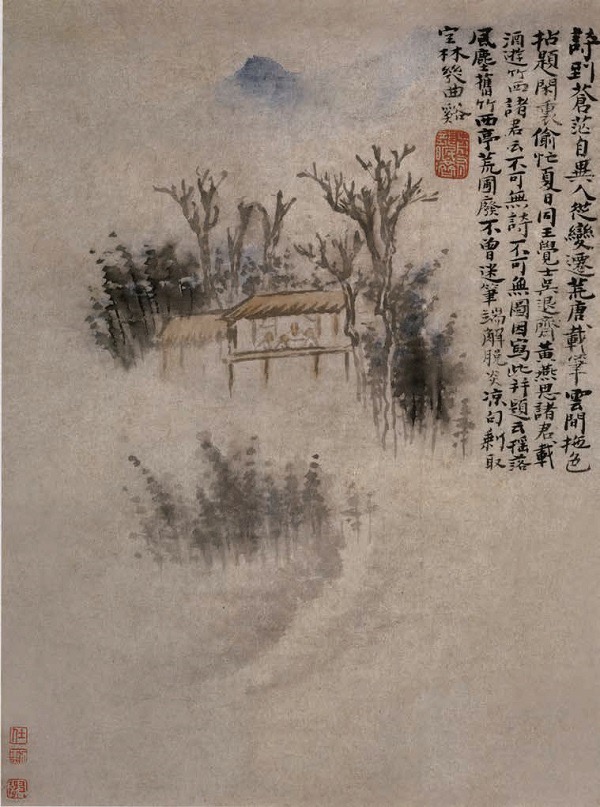
Shi Tao's paintings
Nanhexia Street was the residential area for officials and wealthy businessmen in the Qing Dynasty, and a gathering place for salt merchants from Anhui, Hubei, Hunan and Jiangxi.
Today, there are more than 70 streets and alleys of various sizes in Nanhexia, which are connected in a winding manner. At the right end of Dingjia Bay, there is a secluded alley called Suchang Street, which was where Su and Kun artists lived in the Ming and Qing Dynasties. On the right side of Suchang Street, there is an alley called Qinglian Lane, which is said to be where Li Bai lived when he came to Yangzhou.
Dashu Lane is located on the east side of the middle section of Dingjia Bay. There are two theories about the origin of the name of Dashu Lane. One is that Dashu Lane is composed of several lanes, shaped like the branches of a big tree. Another theory is that there was a "Dashu Hall" where salt merchants gathered in the lane in the early Qing Dynasty. Shi Tao painted in Dashu Lane many times before he moved into Dadi Thatched Cottage.
It is particularly worth pointing out that the existing Pianshishan House built by Shi Tao is located in the southeast of the city, with Nanhexia in front of it, Beihexia in the east, and a lane named Dashu Lane behind it.
Shi Tao has a poem "On the Picture of Mountains Across the River":
I have just built a new hut and am delighted to meet my good friend returning.
More than three thousand miles away, there is a river across the river.
The frost shines brightly on the sandbank, the sound of the bell is hidden behind the abandoned tower.
It's really amazing that we have such a great relationship, and I want to present two difficult talents to you.
This poem was written in the winter of Bingzi, the 35th year of the reign of Emperor Kangxi (1696), proving that his Dadi Thatched Cottage had been completed and he moved into his new home in the winter.
After moving to Daditang, Shitao obviously downplayed his experience as a monk and even deliberately changed into Taoist attire. Although he still socialized with monks and visited temples, he still used seals engraved with his original Buddhist name on his calligraphy and paintings. The only difference was that he began to write the place of creation as "Daditang".
In May of the 38th year of the Kangxi reign (1699), Shitao's old friend Xu Yimin (Jin'an) visited Shitao at Dadi Thatched Cottage.
The Xu family was not only wealthy, but also enthusiastic about social welfare. They donated money to build schools many times. Xu Yimin was involved in art collection early on, and his younger brother Xu Huanling was also an important art patron in the early Qing Dynasty. The Qu Yuan Memorial Hall in East Lake, Wuhan has a collection of "Zheng Banqiao's Inscription on Xu Bai'an's Li Script Scroll", which shows that Zheng Banqiao admired Xu Yimin's calligraphy and proved that Xu Yimin had considerable achievements in calligraphy.
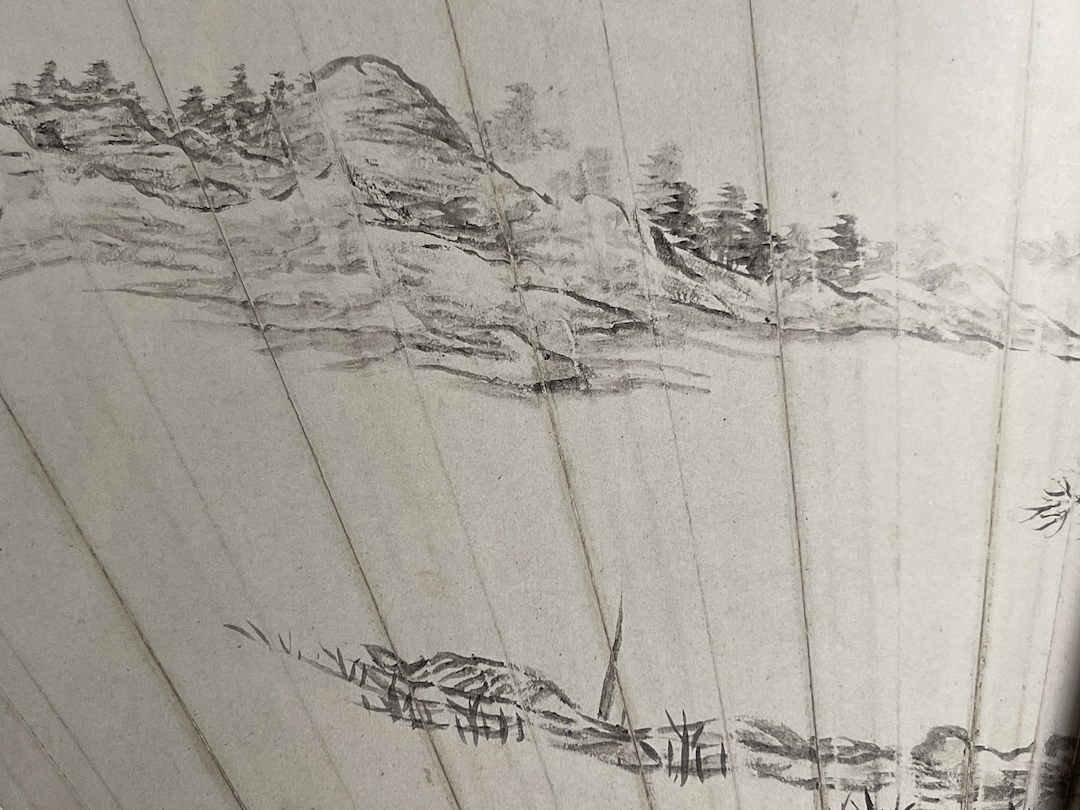
Shi Tao's paintings

A detail of Shi Tao's painting "Zhuxi"
Shi Tao talked to him about the beauty of Huangshan, so he painted "Huangshan Scroll", which became Shi Tao's representative work of Huangshan in his later years. At the end of the scroll, there is a long poem, which gives a passionate and vivid praise of the beautiful scenery of Huangshan. At the same time, Shi Tao also mentioned that when Shi Tao talked about the beautiful scenery of Huangshan to Mr. Jin'an five years ago, Mr. Jin'an did not agree and thought it was exaggerated. But when he visited Huangshan in person, he immediately hosted a banquet for guests and praised Huangshan. Judging from the sentence "All the guests are friends of Huangshan" in the poem, those who went to Mr. Jin'an's banquet were basically from Huizhou.
Jiang Shidong (Daizhan), a Huizhou merchant, was also a long-term collector and sponsor of Shitao's paintings and calligraphy. Jiang Shidong himself was good at calligraphy, and was a wealthy businessman. He was generous and would do what was right, and his family was rich in collections. Jiang Shidong had 8 sons, of whom Jiang Yu and Jiang Xun were the most famous, and they were called "the two Jiangs of Guangling" at the time. Jiang Xun's collection of calligraphy and paintings was the richest in the world, and his son Jiang Deliang inherited his father's business and was famous for his collection. In February of the 38th year of the Kangxi reign (1699), Shitao watched paintings in Jiang Shidong's Daizhan Thatched Cottage and saw "Wang Liujian's Imitation of Huang Dazhi's Endless Landscape Scroll". Shitao wrote a long title after the scroll to express his views on the painting world at that time. It is one of the important documents for studying Shitao's painting ideas. In April of this year, Shitao responded to Jiang Shidong's invitation and added scenery to a landscape painting by Bada Shanren.
However, no matter where he was, no matter how good his friends were to Shi Tao, it was after all a temporary residence and not his "home".
Shitao began to build a "home" for himself.
The place Shitao chose is located in a crowded residential area outside the north gate of the east wall of the old city, namely the Great East Gate. This piece of land is squeezed between the city wall and the canal, and it is not even clear whether it belongs to the new or old city.
The area around Dadong Gate is connected to Tianning Temple outside Gongchen Gate. In the Jin Dynasty, this area was Xie An's villa. As time passed, the city was built in the middle of this area, and the city canal was dug inside and outside the city. Except for a few thousand-year-old ginkgo trees, it is difficult to find the remains of the past.
In the Qing Dynasty, in addition to the large-scale Tianning Temple, there are also Zhenwu Temple, Mars Temple, Mituo Temple, Epiphyllum Nunnery, Zhunti Nunnery, Jiulian Nunnery, and Xiaositu Temple along the river.
Li Dou, who lived not too long after Shi Tao, described this area in Volume 9 of Yangzhou Huafanglu:
At the foot of the city outside the Great East Gate, there are houses along the river. The road is under the city, three to five feet wide, and the people in the village call it Lancheng Lane. It turns east to the river. There used to be many monsters in the lane. Every night, there is a man in green clothes about four feet tall. When he sees people, he pulls their clothes and asks for raw meat slices. When he sees lights, he hides away. The residents are troubled by this. A Taoist priest begs for mercy and says that this monster is easy to get rid of. He orders a stone to be erected on Mount Tai, and three slices of raw meat are offered to it on New Year's Eve. The stone is erected according to the law, and the monster disappears.
Outside the Great East Gate, at the foot of the city, by the river, half of it is the wall behind the houses of the residents, and half is the road by the river. There are no riverside houses, but the home of the local prostitute Wang Tianfu, which has three riverside houses outside the gate, half in the river and half on the bank, with flower stands outside and window lattices in the middle. It is the most beautiful part of the East Water Gate.
The environment here is certainly not elegant. Shi Tao said that he could even hear the footsteps of pedestrians when he was sleeping. But this place also has "advantages": for example, the land price is not more expensive than that of prosperous areas, and it is close to the most lively Xiaoqinhuai Canal District in the city. There are also many of his business friends in the new city not far away. They are the main buyers and collectors of his works. On the other side of the river, you can also see Yangzhou's landmark building: Dongzi Temple. Qionghua Temple is located on the avenue leading to the new city through the Great East Gate.
In the Biography of Dadizi written by Li Lun, the description of Dadi Thatched Cottage is very simple:
He returned to the south and settled outside the Great East Gate of Yangzhou. He built a house with a few rafters facing the water and named it "Dadi Hall". Hence, he was called "Dadizi".
Because the house was not spacious and tall, Shitao had no way to hang the "Dadi Thatched Cottage" given to him by Bada Shanren in a suitable place. In his letter to Bada Shanren, he hoped that Bada could paint another "Dadi Thatched Cottage" according to his request:
Ji wanted to ask the master for a small painting, three feet high and one foot wide, of an old house with a few rafters on a flat slope, a few scattered branches of an ancient catalpa tree, and an old man in the attic. It was the Dadizi Thatched Cottage.
Some researchers claim that Dadi Thatched Cottage, with its ancient trees, old houses, halls and pavilions, has many garden features, but this is probably not the case.
Because of his residence "Dadi Thatched Cottage", Shitao also gave himself the nickname "Dadi Zi" in the last few years of his life.
In the spring of 1697, he began to sign a series of his works with the words "Daditang".
In addition to the meaning of cleansing and washing, the "di" in "dadi" is also related to the Dadi Mountain in Yuhang.
Datu Mountain is one of the two famous mountains in Yuhang. The "Da Di Dong Tian" in Volume 24 of "Xianchun Lin'an Records" explains the meaning of its name as: "This mountain is quiet and peaceful, and it can cleanse the mind, hence the name." Some people even trace the origin of Taoism in Dadi Mountain back to the third year of Yuanfeng of Emperor Wu of Han (108 BC). In the first year of Shunzhi (1644), the Ming Dynasty was destroyed. On the one hand, Dadi Mountain attracted many Ming loyalists to retreat here; on the other hand, it was supported by Emperor Shunzhi and Emperor Kangxi, so its prosperity can be imagined.
The 34th cave of the 36 Taoist caves in Dadi Mountain belongs to the Longmen branch of Taoism, and its status is comparable to the Linji sect of Zen Buddhism. In the 32nd year of Emperor Kangxi's reign (1693), Shitao left Beijing and returned to Yangzhou. In the summer, his friend Zhang Jingwei traveled to western Zhejiang. Before leaving, Shitao, at his friend's request, painted a hand scroll for him in the form of memories: "Viewing the Mountains in Yuhang". The inscription reads: "Viewing the Mountains in Yuhang, drafted for Mr. Shao Wen, sent to ask for your extensive teaching. Monk Kugua Ji."
What Shi Tao called "drafting" is just like what he always advocated "searching for all the strange peaks to make drafts". He disdains to make mechanical descriptions of the scenery, but rather is moved by the mountains and rivers. The hermits, anglers, visitors and lone travelers in the mountains and rivers can all evoke his emotions. The fairy mountain theme, which has been highly praised since the Han Dynasty, adds an unspeakable beauty of fantasy to Shi Tao's landscape paintings.
When Zhang Jingwei returned from Yuhang, Shitao added another inscription on the painting:
Outside the lake is the green Dadi Mountain, and I feel lost as I write and send it.
I don’t know if it is Yuhang Road, but I revisit it on paper with my idle eyes.
In the winter of the year Guiyou, Mr. Jieting took this scroll to travel to Yuhang. When he came back he said it was no different from Dadi's. I hope you can confirm it. If I can visit again, I will send it to you again to make you laugh.
In fact, when Shitao wrote this inscription, almost 30 years had passed since he last visited Yuhang.
Shi Tao used "Da Di" as his name, which first appeared on the album of "Qinhuai Reminiscence", which meant that Shi Tao bid farewell to Buddhism and his past.
In the 39th year of the reign of Emperor Kangxi (1700), Shi Tao said in his poem "Gengchen New Year's Eve":
How can I bear to be born at the wrong time? I have no home and no family, so I pretend to be Gautama.
Now all the great cleansing is thrown away, and the early echo in the heart of this night is ashamed.
I wrongly blame you for having no sympathy for you, just because I have seen you and talked about you lightly.
Don’t be sad when you hear this, for Qingxiang is not a man!
The sixty-year-old Shi Tao stated in his poem, "Even with this blood and heart, I will not end my life with shame." From now on, he abandoned all his past and welcomed the new self.
Around the 39th year of the reign of Emperor Kangxi (1700), Shitao wrote to Bada Shanren—the two had only corresponded and had never met—first saying , "I heard that Mr. Ji was sixty, seventy-four, and seventy-five, and could climb mountains like flying, a true immortal. Ji is almost sixty, and can't bear all the things." Then he said that the size of the previous painting was a bit large, "the house is too small to fit it", and it would be better to paint a smaller vertical scroll, three feet high and one foot wide, with Dadi Thatched Cottage and a few ancient trees. Shitao also emphasized:
The book is written by Da Dizi Da Di Caotang, and the book is written by the monk Mo. The people with hats and hair are all washed upwards.
This was Shi Tao's final enlightenment and also the final destination of his life.
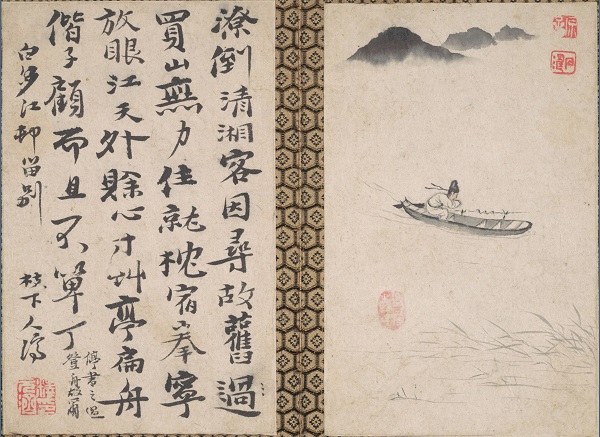
Shi Tao's paintings
However, his livelihood seemed to have always been difficult. In addition to selling paintings to make a living, he also devoted himself to writing "Painting Quotations", which was regarded as a classic by later generations - this is a summary of his artistic life.
When Shitao was painting, there was a young man who often stayed by his side. This man was Gao Xiang, one of the Eight Eccentrics of Yangzhou, who was only 18 years old at the time.
In July of the 46th year of Emperor Kangxi's reign (1707), Shitao wrote "sick wrist" on his works, and he never signed his name to his works again. "Sick wrist" may not just be a problem with the wrist, but may be a problem with other parts of the body, which affects the wrist. As his condition worsened, Shitao should have died in the autumn and winter of that year, and was buried in the cemetery that had been decided before his death, Yangzhou Shugang.
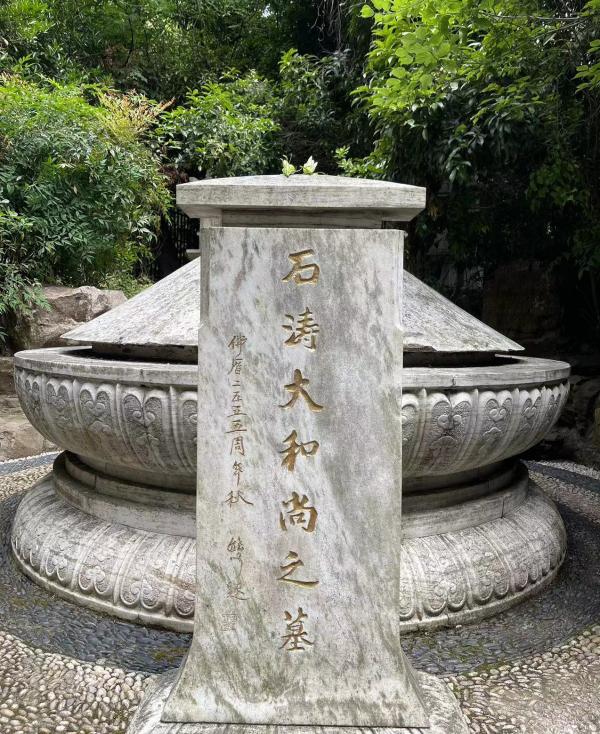
Tomb of Shi Tao
Shi Tao had no children during his lifetime. Earlier that year, he painted a picture of a tomb gate for himself and inscribed a poem that was cold and sad:
Who will pour a stone of wine before spring and sprinkle it on the grave after snow on Solitary Mountain?
